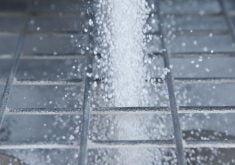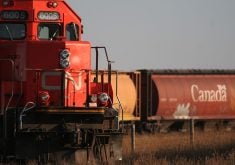Producers who push their high clearance sprayers past 20 m.p.h. but still want more are beginning to buy their own airplanes.
Today’s trend of producers buying spray planes reflects the scene 25 years ago when farmers began buying self-propelled sprayers, which at the time were considered contractor territory.
Odd Job for 800 gallon spray planes
Today, few prairie farms don’t have their own high clearance units.
The rationale for buying a spray plane in 2015 doesn’t differ much from the rationale for buying a high clearance machine in 1990. The more acres a producer farms, the more of a challenge it is to apply crop protection chemicals and top dress nitrogen at just the right time.
The latest generation of spray planes have 800 gallon hoppers and working speeds up to 160 m.p.h.
However, farmers don’t necessarily need to write a million dollar cheque to move from a ground to an aerial sprayer. A few older spray planes are around and stringent Canadian regulations have prevented them from falling into the junker category.

Two years ago, Blaine Gatez bought a 400 U.S. gallon, 1989 Air Tractor 401 through Yorkton Aircraft. The purchase price for the 600 horsepower plane, with all service work up to date, was $250,000 plus $80,000 for the latest aerial applicator technology.
He bought the plane to do double duty, working on two widely separated farms totalling 24,000 acres. Blaine and his father, Gerald, run the parcel north of Calgary while Blaine’s brother-in-law, Peter Cissell, operates the farm in the Peace River Valley.
The two sites are managed as part of the same corporation but have two separate sets of machinery and staff because of the distances. The spray plane is the only shared piece of equipment. The 26-year-old, radial engine plane has a three hour flight, plus one fuel stop, between the two farms.
Gatez had contracted aerial application over the years for fungicides and insecticides, plus a small amount for herbicides. He said custom aerial applicators at both farm locations did a great job, but he felt that he sometimes received a more uniform application with his own ground equipment. However, there are drawbacks to ground equipment.

The tires rut up the field when it’s wet and may spread disease when spraying fungicides. The problem can get out of control by the time all the acres have been covered on the ground.
That’s not likely to happen if the weather allows the plane to fly, he said.
“The availability of a spray plane, either a custom applicator or our own plane, opens windows for us when Mother Nature and her environment have closed them,” he said.
With two farms situated 800 km apart, they often have one farm dry enough for ground application while the other requires the airplane.
“This airplane is a tool we use when our ground rigs shouldn’t go into a field, usually because we don’t want to leave that footprint,” he said.
Read Also

More work wanted on removing red tape
REGINA — Canadian farmers risk falling further behind competitors if two main federal agencies don’t become more efficient and responsive…
“As for which does the best job, I’ve conducted my own tests comparing our ground sprayers to our airplane in fungicide application. In every test we ran, there was no yield benefit for either type of machine. We had exactly the same yield in all cases.”
Gatez tweaked the airplane and spray equipment to accommodate the latest control technology, most of which is still not used by aerial applicators. That included a Sat loc G4 guidance system with AutoSpray on/off enabling, along with the Intelliflow Flow Control.
Use of the new technology was possible only because the two farms have extensive field mapping, which allows them to fly a prescription map with their AT-401 in the same way they use a prescription map in their high clearance sprayers.
“What we have here is a variable rate airplane, which knows its precise location in the field at all times. By using our maps, we’re able to apply different rates in different zones, whether we’re spraying with the airplane or a ground rig,” he said.
“This ensures that the airplane cannot apply anything outside the boundary of the field. It’s a forestry program, and as far as we know, we’re the first farmers in Western Canada to do this.
“This can work for us because it’s our own plane, our own maps and our own spatial references. Because of that, we’re the only ones who know how to combine this information so we have no errors and we have the correct rate at the correct location.”
At the end of each spray job, the computer generates an as-applied map showing exactly where the airplane flew while inside the field boundaries as well as outside the field boundaries. This is a bonus for any spray plane working close to non-farming neighbours who may have concerns when they see spray planes in the sky.
The plane is equipped with Micronair rotary atomizer nozzles, which require the plane to run slightly higher above the crop than it does with conventional hydraulic nozzles.
The system tells the pilot what his height from the crop should be, which is usually 12 to 14 feet.
They also have a complete set of conventional nozzles. Each nozzle setup is mounted on its own boom, so changing from one to the other is a matter of changing booms, which takes two hours.
Because of the controversy over rotary versus conventional, Gatez ran his own spray coverage trials using his own rotary and conventional nozzles.
“The results were conclusive,” he said.
“The rate of two gallons water per acre with our atomizers gave us the same coverage as three gallons water per acre with the conventional nozzles. We’re going to be doing more of these tests.”
Clint Sutter farms at Kelvington, Sask., along with his father and brother. They had seldom used the services of aerial applicators in the past, but Clint and local pilot and business partner Troy Hillaby paid $1 million last winter for a new 510-gallon capacity Thrush spray plane.
The G series indicates the plane is fitted with the latest General Motors turbine engine.
The Sutter farm is in northeastern Saskatchewan, which receives a lot of rain, and farmers there are accustomed to spraying fungicides. The issue had grown big enough by 2014 that they were looking at buying a second high clearance sprayer to keep up with things. However, Mother Nature intervened in June with phenomenal rainfall.
“It wouldn’t have mattered if we had five more ground sprayers, we couldn’t have gotten any of them on the fields,” he said.
It was finally clear to the family that they needed an airplane rather than another high clearance sprayer.
He said they looked all over for used spray planes, but couldn’t really find anything to fill their needs.
The used spray planes hold their value well and they were running out of time, so they decided to buy a new one.
“Our partner, Troy, has always helped put the crop in and take the crop off. During the summer he flies helicopters in the bush in northern Alberta and B,C., so he’s the ideal partner, and he’ll do all the flying.
“Once we get things sorted and working, we’ll do custom spraying for other farmers in the area. This year, we can spray within a 25 mile radius as flying farmers. By next year, Troy will have his license so we can custom spray beyond that circle.
“Before we took the new airplane home, Yorkton Aircraft installed a Sat loc control system. We can spray according to prescription maps just like we were driving our high clearance sprayer.”
For more information, visit www.thrushaircraft.com, www.yorktonaircraft.com and www.airtractor.com.


















